Mini adventure: how far can an electric car go?
- Published
Brian Milligan reaches his final destination of Edinburgh
The BBC's Brian Milligan has driven an electric Mini from London to Scotland, using only public charge points. Here is his diary of that journey.
DAY FOUR
Miles achieved: 484
Miles to go: 0
It took 4 days, some serious thermal underwear, and copious amounts of waiting.
But my electric car and I finally made it to Edinburgh.
There were plenty of nervous moments, and a rather low-key entry to the Scottish capital.
After all, I was driving at 30mph and was shivering with cold.
On the last leg I'd got suddenly over-confident, and had a serious dose of range anxiety.
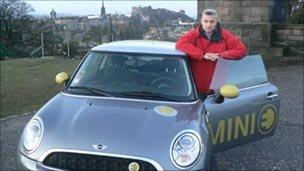
It has been a slow journey but Brian and the mini finally made it to Edinburgh
At one point my range indicator showed 48 miles charge left on my battery, with 50 miles still to go.
Hence the slow speed, and the lack of heater.
6 mph average
Including the time spent both charging and driving, I managed an average speed between London and Edinburgh of just 6mph.
Not exactly impressive, or very practical, but then I'm sure Stevenson's Rocket didn't go very fast the first time he tried it.
And there certainly was a moment when I didn't think I'd make it at all.
I'd got to Wark, close to Kielder Forest in Northumberland, at what I thought was the last outpost of electric charging points in England.
From here it is 87.1 miles to Edinburgh.
The publican of the Battlesteads hotel, Richard Slade, didn't think I'd make it.
"You're going to have difficulty at the end," he said gloomily.
In summer, it would have been perfectly possible, as warmer temperatures take the range of the electric Mini up to 100 miles.
But in the cooler winter climate, I'd been managing between 70 and 80 miles.
At this moment I heard that the UK's most recent charging post had just been installed at a garden centre at Berwick on Tweed.
Last week in fact.
A quick look at the map, and we calculated it was about 70 miles away, just within range, and perfectly positioned for the last leg to Edinburgh.
Last Post
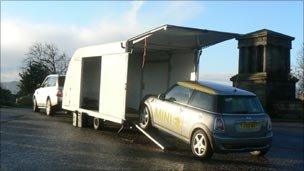
The car is heading home but not under its own steam this time
The drive across Northumberland, through the towns of Bellingham and Rothbury, is surely one of the most spectacular, and under-rated, in England.
We hurried over misty moorland, and through sunlit villages like Eldon, its streets and corners still heaped up with snow.
And soon there it was, at the Berwick Garden Centre: the last post in England; my mini and I the first customers.
Without this, the drive to Edinburgh would not be possible.
With it, the electric car can claim to be something which so far it hasn't been: a vehicle for travelling long-distance, as well as to the supermarket and back.
My point is that if anyone is prepared to spend £23,000 or so on an electric car, they surely don't want to have to buy a petrol one as well, just so they can drive out of town at week-ends.
Sweet Combination
This journey has been laborious, impractical and time-consuming.
But from here on out, the technology will improve rapidly.
We are in a golden age, where manufacturers are pouring millions of pounds into research, while governments across the world are prepared to subsidise both the cars and the charging posts.
That is a sweet combination.
By the end of next year, the UK will have 4,000 charging posts across the country.
Your car's sat nav will guide you straight to them, so there'll be no time wasted while you hunt for them.
When you plug in, your car will get an 80% charge in just 20 minutes.
Meanwhile fuel prices continue to rise.
The economics of electric motoring, and the practicalities, are constantly changing.
But from where I've been sitting for the last four days, there's only one way those economics are headed.
And now I'm heading home too - on the train this time.
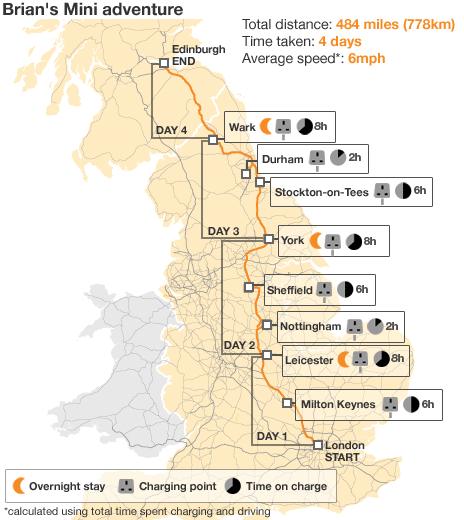
DAY THREE UPDATE - THE RACE IS ON
It seems I have competition on my trip: a driver from the Tesla Motors Club, external is now driving one of the sports cars along the same route as I am using.
The trip - which is supported by the comedian, actor and electric car fanatic Robert Llewellyn, external - seems to be motivated, at least in part, because they feel my test is an unfair test of electric cars.
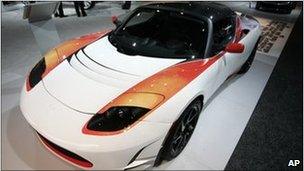
Is it a fair race?
(The editor of the BBC News business and economics unit has also responded to this criticism; you can also leave comments here)
It's nice to see Tesla joining in the spirit of pioneering challenges, but their challenge is not exactly in the spirit of fair play.
The Tesla Roadster costs around £88,000. For that money you expect far better performance than with a standard electric car, and far better range. You get it.
The Roadster also does not qualify for the government subsidy yet, because the Department for Transport has yet to receive a "complete application from Tesla" for the scheme. Nine cars currently do qualify for a subsidy.
Would you measure flying time between London and Edinburgh by using a Eurofighter Typhoon? I think not.
My aim was to try this challenge with a mass-market car, and to use the opportunity to test the charging network more than the car itself.
Throughout the trip we have been mentioning other types of car, and the technology that is to come in the very near future. Both as far as car batteries are concerned, and the charging posts themselves.
DAY THREE
Miles achieved: 285 (460km)How far will an electric car go?
Miles to go: 199 (320km)
We are approaching York, and I begin to suffer another bout of post traumatic stress.
By that I mean stress in finding a post at which to charge my car.

Pupils from Preston School, Stockton-on-Tees crowded around the car
If I can't charge here, there is no other post for over 40 miles (65km) in each direction, and the journey to Edinburgh will fail.
Suddenly we see the lights of the Waitrose supermarket, and stress levels reduce.
Like the welcoming beams of a lighthouse, the blue luminescence of the charging point shines out across the car park.
But until today, this charge post will only work for a maximum duration of two hours.
The idea of that is to stop people blocking access for everyone else.
And I need to charge here for 10 hours.
Then Vicky, the manageress here, tells me that the company have just altered the software especially for me, so I will be able to charge overnight.
I feel like dancing around the car park.
'Really cool'
At 7am the next morning we head off to Preston Hall near Stockton on Teesside. We pull over and plug in.
An army of wellington boots and brightly-coloured lunch-boxes is striding through the puddles towards us.
Suddenly my Mini is surrounded by about 50 children from Preston Primary, eager to see what all the fuss is about.
"That's really cool," says 9 year-old Hunter.
"I know what car I want when I'm older," comments 6 year-old Jake, "and it's that one."
This is a generation that needs no preaching when it comes to cars that are eco-friendly.
But they're also aware of some of the economic complexities involved in predicting the future.
They know that petrol is getting more and more expensive, and they also know that electric cars are expensive too.
"What price do you think electric cars will be in six years time?" asks one young girl.
I guess, correctly, that she is 11 years-old.
Car envy
Also gathered in the car park are some officials from Stockton council.
They turn out to be a bunch of electric car fundamentalists, who've turned up in their own electric car, an i-miev.
I look on enviously, as Mitsubishi's i-miev actually has a back seat, and a boot, which the Mini doesn't.
Goodness me, what I could do with a back seat.
Suddenly I realise that this is the electric equivalent of pulling up at the lights, and glancing at the Aston Martin which has just drawn up alongside you, while you try to look cool in your Robin Reliant.
It's true: when it comes to electric cars, there's always a newer bit of technology on the way.
Next month's arrival of the Nissan Leaf will only be the start of that process.
DAY TWO
The practical side of driving an electric car
Miles Achieved: 181 (290km)
Miles to Edinburgh: 303 (490km)
It's 7.30 in the morning.
We're proceeding up the Fosse Way in Leicestershire at about half the speed the Romans must have managed in their chariots some 1,500 years ago.
This is not because it's the local rush hour.
It's because, even at this early hour, I am already fretting about the range of my electric car, and I have slowed down to forty miles an hour.
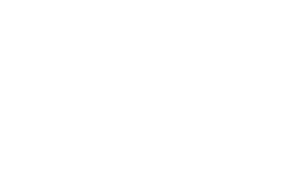
News of the first customer in three years quickly spread
And turned off the heater.
At one stage the display says I have 18 miles (29km) charge left in the battery, and it's nearly 20 miles (32km) to Nottingham.
But then my little Mini is apt to be a little vague in the mornings. Just when I need precision.
However the beauty of electric motoring is that one worry is quickly overtaken by another.
So it is that "range anxiety" is subsumed by "charging post anxiety."
Finding the post
Charging post anxiety comes in two virulent forms.
The first is fear that you can't find the charging post.
The second is that some other electric motorist will be parked up on your charging bay, and could be there for anything up to ten hours, ruining your travel schedule by up to a day.
Given that Nottingham has just two charging bays in the whole of its metropolitan area, both forms of charging post anxiety are now in play.
We enter the large Victoria Centre car park (well one of them) and drive round for a good half hour trying to spot one of the two likely plug sockets. Across the gloomy car-park this isn't easy.
However, we finally find an attendant who can help us out.
We find the charging point and plug in.
'First Customer'
Suddenly a cloud lifts; news spreads that someone is actually using the electric charging point for real; car-park attendants from all over central Nottingham are summoned by walkie-talkie to come and admire the spectacle of an electric car plugged in to a socket.
"Welcome to the Victoria Centre," says the customer services co-ordinator, Gary, who is first on the scene.
"You're our first customer in the three years!"
He is quickly joined by the yellow jacketed Natalie, Amy and Robert.
We are hastily awarded the ultimate prize: free parking for at least two hours.
Then it's back on the road, for the 43 mile (70km) trip to Meadowhall Shopping Centre in Sheffield.
There are about 8 charging points in the centre, so I've learnt by now that no one else will be on them.
Furthermore I venture to suggest in advance that no one else has EVER been on them. At least not for real.
But can we find them? Does anyone know where they are?
As I say, just when one form of charging post anxiety subsides, another takes over.
DAY ONE
The electric car takes about eight hours to recharge
Miles achieved: 110 (180km)
Miles to Edinburgh: 373 (600km)
The sign at the side of the M1 says it's 39 miles to Leicester.
Coincidentally my electric mini says it has 39 miles left in the battery.
It's going to be a close-run thing.
It's only day two of my electric mini challenge, and I already have visions of calling out the RAC to tow us into Leicester, or having to recruit some friendly citizens to give us a push for the last few metres.
Meanwhile I slow down, and turn the heating off.
My producer, Joanna, with help from Google, tells me that a woman from Bristol was banned from driving for doing just 10 mph on a motorway.
It's not quite that bad yet, but it soon could be.
The trouble was that when I left Milton Keynes, the mini's display declared that I had 75 miles (120km) worth of charge.
I knew, as only an electric motorist can, that the distance between Milton Keynes and Leicester is 55.7 (89.6km) miles.
I therefore thought that Leicester was safely in range.
As it turned out, we made it into High Cross car park with 4 miles to spare.
Here there are 105 spaces for charging an electric car, and we are the only customer.
Long wait
Earlier we reached Milton Keynes, a 55 mile (88km) trip from London (that's 55 miles exactly, since you ask).
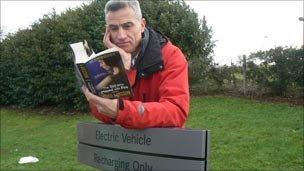
Little to do but catch up on a bit of reading
As I plugged into the post at the Mercedes Benz headquarters, it began to dawn on me that I was now a visitor to Milton Keynes for at least six hours.
In fact it was not even Milton Keynes. More the outskirts.
After two hours, I check the battery level, in the vain hope that the man from Mini UK was being unduly pessimistic about the charging time.
He wasn't.
And there's not a lot to pass the time at Mercedes, other than a rather fine collection of chick lit in the company canteen.
Not feeling up to Penny Vincenzi, I check the battery levels again.
58 miles (93km). Still far too risky.
Golden Age
So, in the same way that pioneering motorists in their 1930's Humbers might find themselves stranded in a village pub after running out of petrol, today's electric motorist can expect to find himself in all sorts of places he might otherwise never go.
Only most of those places are in a car park just off the M1.
Not such glory being a pioneer these days.
But I am beginning to envy the Burberry cloth caps and the tartan picnic rugs they used to gather over their laps.
Using the Mini's heater can cut the range by 10% or so.
So if they take my advice, today's fashionable eco-motorists will wrap up well, with thermal underwear and thick ski-jackets.
Isn't the Michelin-man look rather in this year?
THE EXPERIMENT
Inside the charge point factory
Just before Christmas, the government proudly announced that 2011 would be remembered as the year the electric car took off.
In an attempt to make that prophecy come true, it announced a subsidy of £5,000 for each electric car sold in the UK.
But what is electric motoring actually like?
Does it bear any resemblance to the smug self-satisfaction of those who glide along in petrol-lubricated luxury, untroubled by the fear that they might not actually reach their destination?
Because despite the hype of the battery revolution, it is still not easy to drive an electric car any further than the supermarket and back.
So, in what is arguably an unfair test of a car designed mostly for short-distance motoring, the BBC decided to try to drive an electric Mini the 484 miles (778km) from London to Edinburgh.
It is unfair in one sense, but surely fair in another: if the electric car really has come of age, won't potential owners want to know that if they wanted to, they could drive it from London to Manchester and back at the weekend, to see uncle and auntie?
Charging network
It would be easy to charge the car by asking successive pub landlords between Westminster and the Royal Mile if they wouldn't mind you plugging into their electricity supply while you had a drink.
That is until you mentioned that it might need a 10-hour charge and would need to leave a cable dangling out of the window overnight.
No, the only practical way for drivers to charge their cars is by using public charge points, of which there are thought to be as many as 500 in the UK.
No-one has actually added them up.
Even OLEV, the government office for low emission vehicles, doesn't know exactly how many there are.
So are there enough? And are they spaced correctly for me to get to Edinburgh within a working week?
Range anxiety
To try and get a better idea of feasibility we went to visit Calvey Taylor-Haw, who runs a business called Elektromotive.
At a factory in Lancing, West Sussex, he manufactures many of the electric charging posts that make up the network.
After looking at the map, he pronounces that the journey as far as Tyneside is perfectly achievable.
But between Northumberland and Edinburgh it will be a significant challenge.
"The gap is 87 miles (140km) ," he says, "which is more than the range of your car.
"Ideally you need another charging post halfway between the two. Otherwise you are going to suffer range anxiety."
From where I'm about to sit, that's a serious understatement.
Read a selection of your comments:
Surely, surely the way to go with electric cars is a system of swapping batteries (drop of the flat, pick up a charged, probably at existing fuel stations), rather than trying to install sufficient charge points? Much less of a technical challenge, all things considered! Robyn Pender, London
I understand the need to provide alternatives, but what happens to the battery when it is spent? I am led to believe that the "green" element of an electric car is so poor because of the disposal of the battery that it is not worth considering. Anni, Yorkshire
I have driven a Reva G-Wiz for about 4 years. It all depends on how one drives it. They will charge up as they go if you go downhill. They work better in summer than winter, even with Lithium Dioxide batteries. Radio, wipers and heater all work off the battery so they all drain it. Use them minimally when you need to go a distance. Extra weight costs power, especially up hills. Deflated tyres cost power. Drag on the car goes (roughly) in proportion with the square of the speed, so you can go further if you reduce your speed. Try to go as far as you can on a low power setting. There must be an optimum speed and have (for no good reason) a figure of 25mph for a G-Wiz. Ben Rickman, Wembley
I can drive from Weston to Inverness in 10 hours, on one tank of fuel, until electric cars have the same range as conventional cars they are not going to be embraced by the masses. It is infeasible for the majority of the population to charge their car outside their home or rely on pit stops every 60 miles or so. Iain, Weston-super-Mare
Will Brian only be driving in daylight as I often wonder how the range of electric vehicles is affected when lights (and heating!!) are used too as these will both use up battery power? also the cost of charging the car to drive to Edinburgh may be pennies but what of the accommodation and extra food he'll need to pay for on the journey while the car is being charged? 87 miles wouldn't even get me to my mums in Hampshire! Andrew Cockerill, Bristol
Most of the first generation electric cars can go 100 miles on a single charge. Most people's journeys are less than 100 miles per day and the electric car is the least polluting and cheapest option for transport by an individual bar walking or cycling. If you have an electric car and have to drive long distances once in a while, rent an old fashioned petrol car. Christian, London
I had an electric Mitsubishi I-MIEV on trial last year. The cold weather ruined the range as batteries work less well when cold plus the heater was a big drain, the LED lights less so. A very smooth drive when it worked, reliability was shocking. Electric cars are fine for committing say 20 miles each way to work at moderate speeds but that's about it so far. Oh, the lack of gears made it theoretically as fast going backwards! Grant Williams, Walsall
I don't think the idea of an eclectic car is to travel long distances over four days. I'm sure I could cycle the same route quicker, taking into account the charging period of 10 hours. I'm not sure what purpose this exercise proves. Nobody would plan a trip to Edinburgh and back that takes 8 days of travel time. Andrew Pick, Doncaster
I ride a Vectrix (Electric Motorbike) to commute - a return distance of about 10 miles. The bike is an absolute dream - reducing my commuting time from 25 to 7 minutes! The drawback (as always) is range; at an average 30mph I can get a full week out of a single charge (cost around 20p). Being a motorbike - the temptation to throttle up on open roads can mean that I only get two journeys on a single charge! Graham Lloyd, Cambridge
What happens when Brian gets to one of these few charging points and someone else has their car plugged in? If you disconnect their car to charge your car, would you get the equivalent of charge-rage instead of road-rage? Are you allowed to disconnect someone else's car if your need is greater. A whole new etiquette needs to be established. Craig Shepheard, St Albans
And if my trip to see uncle and auntie needed to be completed in just two days, what do I do while the car is charging? Oh hang on, I forgot to factor in the forty hours' charging required for the entire trip. So in fact a return trip to see uncle and auntie, including lunch and a game of cards would take at least nine days. One last thing, struggling to see how 20 million cars plugged into The National Grid in any way helps to save the planet. Philip, Congleton
- Published16 December 2010